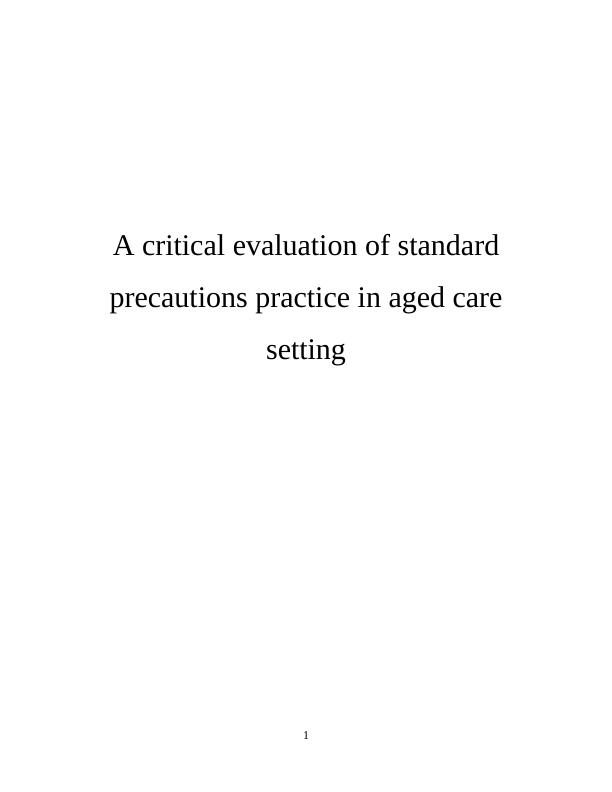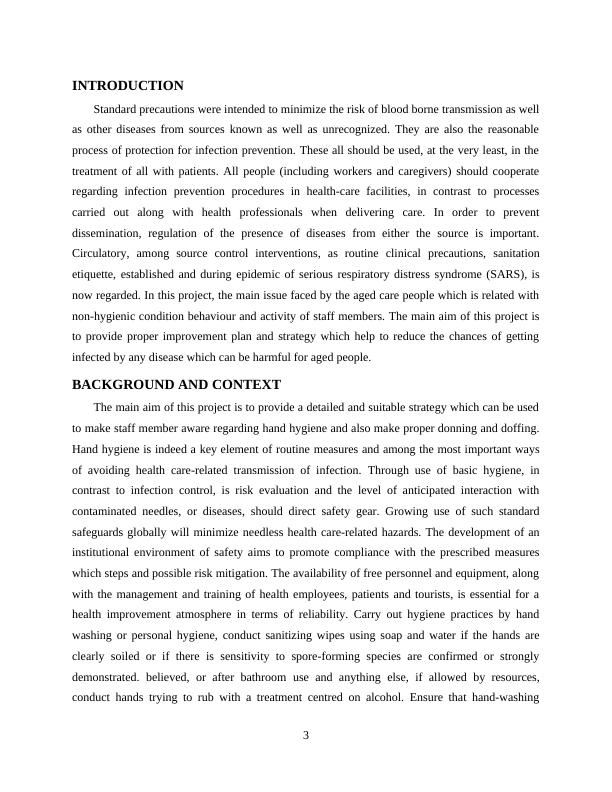Critical Evaluation of Standard Precautions Practice in Aged Care Setting
12 Pages3758 Words41 Views
Added on 2022-12-28
About This Document
This article provides a critical evaluation of standard precautions practice in aged care setting, focusing on hand hygiene and proper donning and doffing. It discusses the challenges and barriers to adherence, strategies to overcome them, and the importance of leadership in infection prevention and control.
Critical Evaluation of Standard Precautions Practice in Aged Care Setting
Added on 2022-12-28
ShareRelated Documents
A critical evaluation of standard
precautions practice in aged care
setting
1
precautions practice in aged care
setting
1

Contents
INTRODUCTION...........................................................................................................................1
BACKGROUND AND CONTEXT................................................................................................1
Strategy............................................................................................................................................3
Evaluation........................................................................................................................................5
CONCLUSION................................................................................................................................7
REFERENCES................................................................................................................................8
2
INTRODUCTION...........................................................................................................................1
BACKGROUND AND CONTEXT................................................................................................1
Strategy............................................................................................................................................3
Evaluation........................................................................................................................................5
CONCLUSION................................................................................................................................7
REFERENCES................................................................................................................................8
2

INTRODUCTION
Standard precautions were intended to minimize the risk of blood borne transmission as well
as other diseases from sources known as well as unrecognized. They are also the reasonable
process of protection for infection prevention. These all should be used, at the very least, in the
treatment of all with patients. All people (including workers and caregivers) should cooperate
regarding infection prevention procedures in health-care facilities, in contrast to processes
carried out along with health professionals when delivering care. In order to prevent
dissemination, regulation of the presence of diseases from either the source is important.
Circulatory, among source control interventions, as routine clinical precautions, sanitation
etiquette, established and during epidemic of serious respiratory distress syndrome (SARS), is
now regarded. In this project, the main issue faced by the aged care people which is related with
non-hygienic condition behaviour and activity of staff members. The main aim of this project is
to provide proper improvement plan and strategy which help to reduce the chances of getting
infected by any disease which can be harmful for aged people.
BACKGROUND AND CONTEXT
The main aim of this project is to provide a detailed and suitable strategy which can be used
to make staff member aware regarding hand hygiene and also make proper donning and doffing.
Hand hygiene is indeed a key element of routine measures and among the most important ways
of avoiding health care-related transmission of infection. Through use of basic hygiene, in
contrast to infection control, is risk evaluation and the level of anticipated interaction with
contaminated needles, or diseases, should direct safety gear. Growing use of such standard
safeguards globally will minimize needless health care-related hazards. The development of an
institutional environment of safety aims to promote compliance with the prescribed measures
which steps and possible risk mitigation. The availability of free personnel and equipment, along
with the management and training of health employees, patients and tourists, is essential for a
health improvement atmosphere in terms of reliability. Carry out hygiene practices by hand
washing or personal hygiene, conduct sanitizing wipes using soap and water if the hands are
clearly soiled or if there is sensitivity to spore-forming species are confirmed or strongly
demonstrated. believed, or after bathroom use and anything else, if allowed by resources,
conduct hands trying to rub with a treatment centred on alcohol. Ensure that hand-washing
3
Standard precautions were intended to minimize the risk of blood borne transmission as well
as other diseases from sources known as well as unrecognized. They are also the reasonable
process of protection for infection prevention. These all should be used, at the very least, in the
treatment of all with patients. All people (including workers and caregivers) should cooperate
regarding infection prevention procedures in health-care facilities, in contrast to processes
carried out along with health professionals when delivering care. In order to prevent
dissemination, regulation of the presence of diseases from either the source is important.
Circulatory, among source control interventions, as routine clinical precautions, sanitation
etiquette, established and during epidemic of serious respiratory distress syndrome (SARS), is
now regarded. In this project, the main issue faced by the aged care people which is related with
non-hygienic condition behaviour and activity of staff members. The main aim of this project is
to provide proper improvement plan and strategy which help to reduce the chances of getting
infected by any disease which can be harmful for aged people.
BACKGROUND AND CONTEXT
The main aim of this project is to provide a detailed and suitable strategy which can be used
to make staff member aware regarding hand hygiene and also make proper donning and doffing.
Hand hygiene is indeed a key element of routine measures and among the most important ways
of avoiding health care-related transmission of infection. Through use of basic hygiene, in
contrast to infection control, is risk evaluation and the level of anticipated interaction with
contaminated needles, or diseases, should direct safety gear. Growing use of such standard
safeguards globally will minimize needless health care-related hazards. The development of an
institutional environment of safety aims to promote compliance with the prescribed measures
which steps and possible risk mitigation. The availability of free personnel and equipment, along
with the management and training of health employees, patients and tourists, is essential for a
health improvement atmosphere in terms of reliability. Carry out hygiene practices by hand
washing or personal hygiene, conduct sanitizing wipes using soap and water if the hands are
clearly soiled or if there is sensitivity to spore-forming species are confirmed or strongly
demonstrated. believed, or after bathroom use and anything else, if allowed by resources,
conduct hands trying to rub with a treatment centred on alcohol. Ensure that hand-washing
3

services with safe clean water are available. The prices of products for hand hygiene (clean
drinking water, shampoo, smooth sheets for individual use, hand rub dependent on alcohol). A
handle dependent on alcohol ideally, rubs must be free at the time of Care. Handle instruments
that are soiled through blood, mucous membranes, toxins and waste products in a way that
avoids damage to skin or mucous membranes, clothing contamination and also the transmission
of diseases to many other clinicians and to other patients about the climate. Prior to use with
some other patient, wash, clean, and recycle efficient approach properly. At just the start of
employment, the techniques they adopted when drama etc. diseases, as well as prevention and
treatment education were given to the number of hospices. As the instructions are given with
regards towards hygiene that should really be taken inside a facility wherein the percentage of
clients must not be compromised by the employees because of disease. Members must maintain
sufficient distance for each client and for each decision they make, use hand sprays. They were
also provided with training to recognize the severity of the safety actions taken by staff members
to safeguard them as well as the employees of the staff. Those that are with them. According to
research, owing to this introduction of od strategy, the planning succeeded and enabled the
majority of patients who recover as well as rebound again from disease and also the frequency of
infections was greatly reduced.
However, there are some factors that affect the adherence to the practices of hand hygiene
by Health Care professionals. The risk factors for ineffective or poor hand hygiene adherence in-
cludes physician status, wearing gowns, working during the week, automatic sink, nursing assis-
tant status. Apart from this, the self-reported factors related to poor adherence with hand hygiene
involves lack of paper towels and soaps, under staffing/ overcrowding, the patient required to
take priority, hand washing agents cause dryness and irritation, no role model from superiors or
colleagues, disagreement with recommendations, often too busy/ insufficient time etc. In addi-
tion to this, there are some perceived barriers to hand hygiene including lack of institutional pri-
ority towards hand hygiene, lack of active participation in promotion of hand hygiene at institu-
tional or individual level, lack of institutional safety climate, lack of management sanction of re-
warding compilers/ non compilers. In order to overcome these barriers, it is very necessary to
provide employees with proper education regarding hand hygiene and culture of adherence along
with the feedback on performance. In addition to this, providing easy access to the materials of
4
drinking water, shampoo, smooth sheets for individual use, hand rub dependent on alcohol). A
handle dependent on alcohol ideally, rubs must be free at the time of Care. Handle instruments
that are soiled through blood, mucous membranes, toxins and waste products in a way that
avoids damage to skin or mucous membranes, clothing contamination and also the transmission
of diseases to many other clinicians and to other patients about the climate. Prior to use with
some other patient, wash, clean, and recycle efficient approach properly. At just the start of
employment, the techniques they adopted when drama etc. diseases, as well as prevention and
treatment education were given to the number of hospices. As the instructions are given with
regards towards hygiene that should really be taken inside a facility wherein the percentage of
clients must not be compromised by the employees because of disease. Members must maintain
sufficient distance for each client and for each decision they make, use hand sprays. They were
also provided with training to recognize the severity of the safety actions taken by staff members
to safeguard them as well as the employees of the staff. Those that are with them. According to
research, owing to this introduction of od strategy, the planning succeeded and enabled the
majority of patients who recover as well as rebound again from disease and also the frequency of
infections was greatly reduced.
However, there are some factors that affect the adherence to the practices of hand hygiene
by Health Care professionals. The risk factors for ineffective or poor hand hygiene adherence in-
cludes physician status, wearing gowns, working during the week, automatic sink, nursing assis-
tant status. Apart from this, the self-reported factors related to poor adherence with hand hygiene
involves lack of paper towels and soaps, under staffing/ overcrowding, the patient required to
take priority, hand washing agents cause dryness and irritation, no role model from superiors or
colleagues, disagreement with recommendations, often too busy/ insufficient time etc. In addi-
tion to this, there are some perceived barriers to hand hygiene including lack of institutional pri-
ority towards hand hygiene, lack of active participation in promotion of hand hygiene at institu-
tional or individual level, lack of institutional safety climate, lack of management sanction of re-
warding compilers/ non compilers. In order to overcome these barriers, it is very necessary to
provide employees with proper education regarding hand hygiene and culture of adherence along
with the feedback on performance. In addition to this, providing easy access to the materials of
4

End of preview
Want to access all the pages? Upload your documents or become a member.
Related Documents
A critical evaluation of hand hygiene practices in an aged care facilitylg...
|13
|4809
|86
Infection Control - Assignmentlg...
|4
|1658
|430
Efficacy of Alcohol-gel as a Substitute for Soap and Water Hand in a Clinical Settinglg...
|11
|2884
|214
Preventing Cross Infection in Dental Settingslg...
|16
|4316
|388
Reflection of Infection control in Hospitallg...
|4
|851
|17
Effectiveness of Alcohol Based Hand Rublg...
|9
|2575
|170
